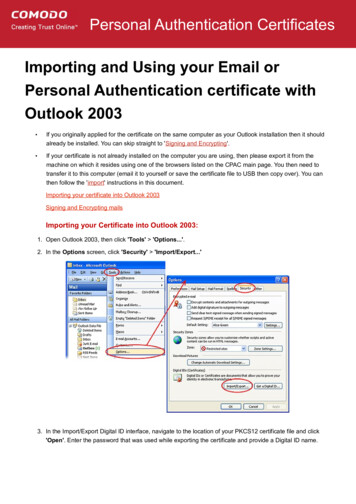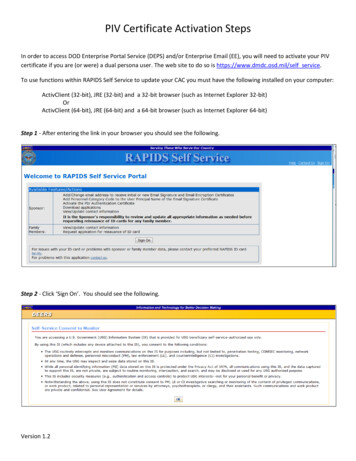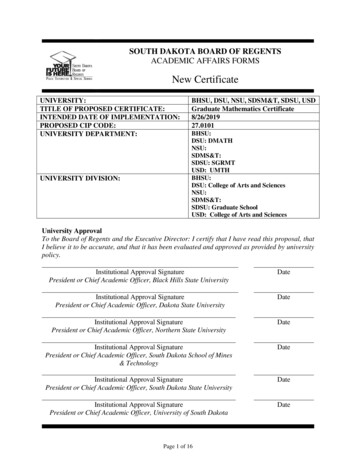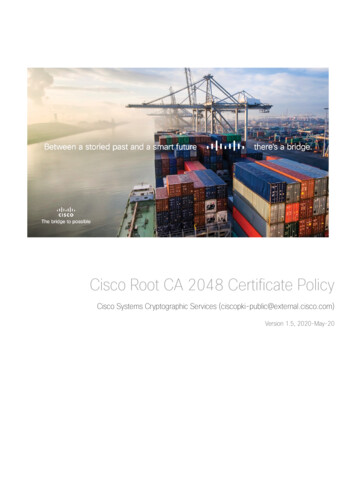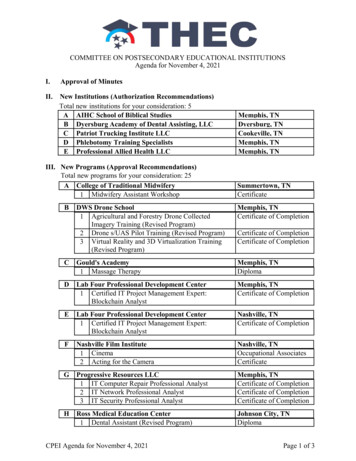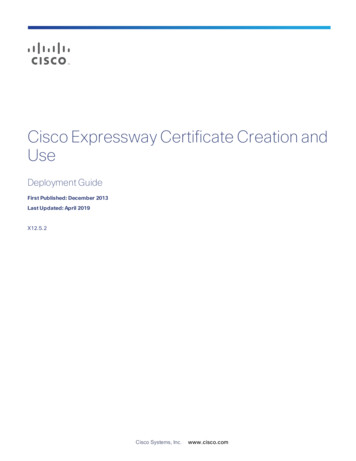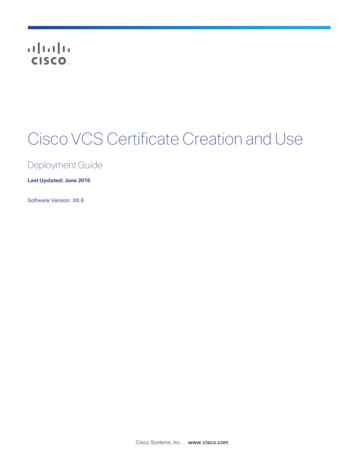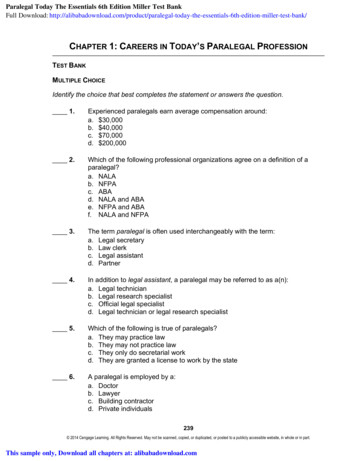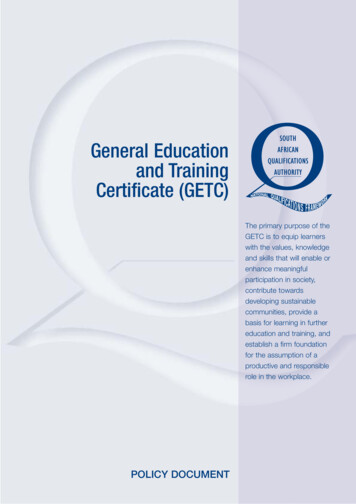
Transcription
General Educationand TrainingCertificate (GETC)The primary purpose of theGETC is to equip learnerswith the values, knowledgeand skills that will enable orenhance meaningfulparticipation in society,contribute towardsdeveloping sustainablecommunities, provide abasis for learning in furthereducation and training, andestablish a firm foundationfor the assumption of aproductive and responsiblerole in the workplace.POLICY DOCUMENT
Write to us atPostnet Suite 248, Private Bag X06WATERKLOOF, 0145Visit us at659 Pienaar Street (cnr. Waterkloof Road)BROOKLYN, PretoriaTelephone us at012 – 482 0800 Switchboard012 – 482 0802 Executive Office012 – 482 0836 Resource Centre and general information012 – 482 0810 Strategic Support012 – 482 0810 Communications012 – 482 0807 Standards Setting and Development012 – 482 0805 Quality Assurance and Development012 – 482 0858 Evaluation of Educational QualificationsFax us at012 – 346 5813 Executive Office012 – 482 0953012 – 346 5809 Secretariat012 – 482 0966012 – 346 5809 Communications012 – 482 0957012 – 346 5809 Information Technology012 – 482 0957012 – 482 0907 Standards Setting and Development012 – 482 0992012 – 482 0991012 – 482 0817 Quality Assurance and Development012 – 482 0905012 – 482 0895 Evaluation of Educational Qualifications012 – 460 2131 Resource Centre012 – 482 0891e-mail us atsaqainfo@saqa.org.zaVisit our website athttp://www.saqa.org.zaDate of publication: October 2001ISBN: 0-620-28289-4Funded by the European Unionunder the European Programmefor Reconstruction andDevelopment
CONTENTSExecutive summary31. Introduction52. Background to establishing the purpose, guiding principlesand criteria for the GETC53. Specific design challenges at the GETC level94. Requirements of the General Education and Training Certificate95. Issues of implementation256. Conclusion27Members of the GETC Stakeholder Forum28References29Glossary30Acronyms32
SAQA’s MissionTo ensure the development and implementation of aNational Qualifications Framework which contributes tothe full development of each learner and to the social andeconomic development of the nation at large.
G E N E R A L E D U C AT I O N A N D T R A I N I N G C E R T I F I C AT EExecutive summaryRequirements1. Each full qualification registered at level 1 on the NationalQualifications Framework (NQF) will be called a General Educationand Training Certificate (GETC) and will conform to the broad requirements recommended in this document.2. Each GETC will provide access to various learning pathways, both vertical and horizontal, in terms of the purpose of the qualification. Thescope of access provided by each GETC will be determined by the qualification itself.3. The primary purpose of the GETC is to equip learners with the values,knowledge and skills that will enable or enhance meaningful participation in society, contribute towards developing sustainable communities,provide a basis for learning in further education and training, and establish a firm foundation for the assumption of a productive and responsible role in the workplace.4. A minimum of 120 credits is required for the GETC, of which at least72 must be at NQF level 1.5. The 20 compulsory credits in language and communication must beobtained at NQF level 1 in one of the 11 official South African languages (Sepedi, Sesotho, Setswana, siSwati, Tshivenda, Xitsonga,Afrikaans, English, isiNdebele, isiXhosa, or isiZulu) or in one of thelanguages promoted by the Pan South African Language Board (theKhoi, Nama, and San languages, and sign language) in terms of theSouth African Constitution (Chapter 1, Section 6; RSA, 1996).6. A further 20 credits in language and communication may be obtained inan additional official language enshrined in the South AfricanConstitution (RSA, 1996) or in one of the languages promoted by thePan South African Language Board (the Khoi, Nama, and San languages, and sign language) in terms of the South African Constitution.7. The 16 credits from the organisational field of mathematics and mathematical literacy must be obtained at NQF level 1.8. The principle is accepted that proposers of a certain qualification candesignate specific areas of study or credits as compulsory within thatqualification, in addition to the fundamentals and in compliance withother GETC requirements and regulations as established by SAQA.9. Proposers of qualifications must liaise with the Education and TrainingQuality Assurance bodies (ETQAs) which quality assure the learningprogrammes leading to the awarding of the GETC on the requirementsfor ensuring coherence of those qualifications.10. A registered GETC can be a unit standards-based or non-unit standardsbased qualification, in accordance with the requirements of the NationalStandards Bodies (NSB) regulations (8[4]). Unit and non-unit standards-based GETCs should articulate on the basis of their exit-level outcomes.11. Learners not meeting the requirements to be awarded the GETC mustreceive a statement of achievement, reflecting the credits obtained oroutcomes achieved.A publication of the South African Qualifications Authority3GETC
GETCG E N E R A L E D U C AT I O N A N D T R A I N I N G C E R T I F I C AT E12. Providers and ETQAs should engage with each other, with stakeholdersin their sectors, and with SAQA on how best to maintain the integrity ofthe GETC beyond the requirement that the purpose of the qualificationbe achieved through appropriate incorporation of integrated assessment.13. ETQAs and providers of learning programmes leading to the achievement of the GETC should collaborate in formulating policies and devising criteria that allow learners to achieve whole or part qualificationsthrough the recognition of prior learning.4A publication of the South African Qualifications Authority
G E N E R A L E D U C AT I O N A N D T R A I N I N G C E R T I F I C AT EGETC1. IntroductionThe need for a document that provides a framework within whichconstructors of qualifications can design a GETC is indicated by: Broad stakeholder demand for guidance in the development of theGETC; The difficulties which NSBs and Standards Generating Bodies(SGBs) have experienced in conceptualising the qualification; and The requirement for the registration of a coherent GETC on theNQF.This policy document outlines the context within which the GETC islocated and discusses some of the difficulties associated with thedesign of the GETC. It addresses particular issues, which constructors of the GETC need to take into account, namely: The purpose of the GETC; Rules of combination; The articulation of the GETC; Progression and credit accumulation; Integrated assessment; and Recognition of prior learning (RPL).The document outlines a number of requirements in addressing theseissues. The final section highlights some of the issues that need to betaken into account during implementation of the requirements contained in section 4.2. Background to establishing the purpose,guiding principles and criteria for the GETC2.1 The legal responsibility of SAQA as per the SAQA Act(Act No. 58 of 1995) (RSA, 1995)The functions of the Authority as per the SAQA Act, No. 58 of 1995,are as follows:The Authority shall: Oversee the development of the NQF; Formulate and publish policies and criteria for:– The registration of bodies responsible for establishing educationand training standards or qualifications;– The accreditation of bodies responsible for monitoring andauditing achievements in terms of such standards or qualifications; Oversee the implementation of the NQF including;– Registration or accreditation of bodies referred to above and theassignment of functions to them;A publication of the South African Qualifications Authority5In accordance withthe Act and theregulations, SAQA,through the NSBSGB structures, isresponsible for theregistration ofqualifications.
GETCG E N E R A L E D U C AT I O N A N D T R A I N I N G C E R T I F I C AT E– The registration of national standards and qualifications;– Steps to ensure compliance with provisions for accreditation;and– Steps to ensure that registered standards and qualifications areinternationally comparable.2.2 The Regulations for National Standards Bodies (NSBs)(RSA, 1998a) and for Education and Training QualityAssurance Bodies (ETQAs) (RSA, 1998b)Among the functions of NSBs as listed in the regulations are thatthey: Ensure that the work of SGBs meets the requirements for the registration of standards and qualifications as determined by theAuthority; Recommend the registration of standards on the NQF to theAuthority; Recommend the registration of qualifications to the Authority; Update and review qualifications; and Liaise with ETQAs regarding the procedures for recommendingnew standards and qualifications, or amending registered standards and qualifications.Among the functions of ETQAs as listed in the regulations are thatthey: Recommend new standards and qualifications to NSBs for consideration; or Recommend modifications to existing standards or qualificationsto NSBs for consideration.In the case of theGETC, there is likelyto be a range ofrecommendations forsuch qualificationswhich cut across allNSBs and SGBs andwhich attempt to fulfila variety of needswithin the educationand training sector atthese levels.In accordance with the Act and the regulations, SAQA, through theNSB-SGB structures, is responsible for the registration of qualifications. Furthermore the NSBs have the function of liaising withETQAs regarding the procedures for recommending new standardsand qualifications, or amending registered standards and qualifications. ETQAs are responsible for assuring the quality of these qualifications. Through liaison with the NSBs they have a direct role toplay in recommending new standards and qualifications as well asmodifications to existing standards and qualifications to NSBs forconsideration. The ETQA structures are not legally in a position toassume responsibility for recommending standards and qualificationsto SAQA, as this is clearly the responsibility of the NSB-SGB structures.2.3 The generalist qualificationsIn the case of the GETC, there is likely to be a range of recommendations for such qualifications which cut across all NSBs and SGBsand which attempt to fulfil a variety of needs within the education andtraining sector at these levels. Provision includes formal schooling,Adult Basic Education and Training (ABET), out-of-school youth6A publication of the South African Qualifications Authority
G E N E R A L E D U C AT I O N A N D T R A I N I N G C E R T I F I C AT EGETCand the learners within learnerships and skills programmes of theDepartment of Labour.The NSB regulations provide general guidelines in respect of thestructure of such qualifications. However, discussions conducted atthe NSB level, indicated that further guidance and clarity was needed.In accordance with the regulations, NSBs are responsible for recommending standards and qualifications to the Authority. However,as mentioned above, these qualifications cut across all NSB fields andacross a variety of contexts of education provision. Since NSBs andSGBs in particular, are regarded as having sectoral interests, it hasbeen suggested that they are inappropriate structures to make suchrecommendations. In view of the fact that SAQA has the responsibility of developing the NQF, it is appropriate that SAQA oversees thedevelopment of the minimum requirements and guiding principles forthese generalist qualifications.2.4 A discussion forum for the development of the purpose,guiding principles and guidelines for the GETCIf the NSB-SGB structures are deemed inappropriate for determiningthe parameters for the generalist qualifications, it is advisable thatSAQA convene a forum to establish the basic principles and minimum requirements for the GETC and recommend these to theAuthority for approval. Alternatively it should recommend a processwhereby these principles and requirements can be established. Onceapproved at Authority level, NSBs will have to ensure that the standards and qualifications at this level, which they recommend forregistration, meet the requirements of the Authority.Before the forum recommends the basic principles and minimumrequirements to the Authority for final approval, there will need to bean engagement with all stakeholders, including the Inter-NSB Forum,and a public comment process.2.5 The GETC ForumAn FETC/GETC forum was established and met on 12 May 2000.The original intention was that the forum would address both theFurther Education and Training Certificate (FETC) and the GETC.This was not possible, resulting in the forum continuing with itswork, but focusing on the FETC. The Authority adopted a FETCpolicy document in April 2001 after an extensive public commentprocess.At the SAQA meeting of 16 August 2000 it was decided that asimilar process should be followed to formulate a policy documentfor the GETC.The following process was therefore recommended and followed: The framework for submissions was established at a meeting heldon 18 September 2000. Issues pertaining to the GETC that neededto be addressed in a policy document were discussed.A publication of the South African Qualifications Authority7As SAQA has theresponsibility ofdeveloping the NQF, itis appropriate thatSAQA oversees thedevelopment of theminimum requirementsand guiding principlesfor generalistqualifications.
GETCG E N E R A L E D U C AT I O N A N D T R A I N I N G C E R T I F I C AT E These discussions were synthesised into a document produced bySAQA staff. The document was e-mailed to all members of theforum before being distributed for comment. Once the commentswere incorporated, the document was ready for distribution by 4October 2000. SAQA then called for submissions from major stakeholders. Theclosing date for initial submissions was 31 October 2000. These submissions were considered in drafting a discussion document for tabling to the GETC Forum, which met on 20 November2000. A discussion document was submitted to the SAQA meeting heldon 6 December 2000. The document was accepted by SAQA as abasis for the wide consultation process. The public commentphase was extended beyond the initial deadline of 15 March 2001to allow for further input into the process. After this extended public comment phase the stakeholder forummet again on 19 July 2001 to discuss public comment receivedand to reach consensus on the changes made to the final documentpresented to the SAQA Executive Committee on 25 July 2001. It was envisaged that the GETC policy document would befinalised at the SAQA meeting of 15 August 2001.2.6 Submissions to the GETCWhile SAQA is primarilyconcerned that theachievement of aqualificationconstitutes astatement ofcompetence in aparticular field, itcannot ignore thedimension of sectoraldifference in the designof qualifications,particularly where twosuch sectors aredifferentiated on thebasis of age.The following submissions to the GETC received at the SAQA Officeby 31 October 2000 – including submissions that were not in responseto the Document for Submissions: GETC distributed in the wake ofthe 18 September 2000 meeting of the GETC Forum but which hadbeen received at the SAQA Office prior to that date – have been takeninto account in compiling their policy document: Department of Education: “Proposal to HEDCOM on: TheGeneral Education and Training Certificate” (received 18September 2000) (Department of Education, 2000b); Interim ABET Advisory Board (IAAB): “GETC Proposal forABET” (received 31 May 2000) (IAAB, 1999); IAAB: “GETC Discussion: Comments from the IAAB, 31October 2000” (received 31 October 2000) (IAAB, 2000); and SAFCERT: Submission on SAQA’s “Document for Submissions:GETC” (31 October 2000).2.7 Public comment on the GETC discussion documentComments on the GETC discussion document were received from awide range of stakeholders. These included the university sector,COSATU, the Chamber of Mines, Department of Education (fromnational and provincial departments), Department of Labour, theorganised teaching profession, SAFCERT and individuals.8A publication of the South African Qualifications Authority
G E N E R A L E D U C AT I O N A N D T R A I N I N G C E R T I F I C AT EGETC3. Specific design challenges at the GETClevelThe challenges facing the designers of a framework for the GETC area function of the complexity of cross-cutting factors that need to betaken into account. The three-dimensional matrix comprises: An age continuum (from children to adult learners); A site-of-learning differentiation (from classroom to factory floorto workplace learning centre to community centre); and A time-of-learning dichotomy (daylight-based versus night-basedlearning).Furthermore the approach and the nature of the learning programmeswill differ substantially from group to group. This has raised the question as to what the term “general” means when referring to a qualification at NQF level 1: “general” in the context of children is quite different from “general” in the context of adults, for example.While SAQA is primarily concerned that the achievement of aqualification constitutes a statement of competence in a particularfield, it cannot ignore the dimension of sectoral difference in thedesign of qualifications, particularly where two such sectors are differentiated on the basis of age (children versus adults). Learning tocount as a child in a schooling environment, for example, is very different from learning to count as an adult in an ABET environment.Since competence is achieved within the learning context of a sectorcompetence and sector should therefore be held in tension.Currently there is no formal certification for any of these sectorsat this level. The education and training system is not geared towardsa large-scale assessment or certification at level 1 of the NQF.There are political implications if a system of formal assessmentis put in place and achievement levels are low. Furthermore, there arehuge cost implications should assessment at this level be on the scalecurrently conducted at the Senior Certificate level.Moreover, there is an imperative to bring the marginalised ABETsector into the mainstream by creating appropriate articulation withformal education provision so that learners can have access andmobility within the education and training system through recognition of their achievements.There is an imperativeto bring themarginalised ABETsector into themainstream by creatingappropriate articulationwith formal educationprovision so thatlearners can haveaccess and mobilitywithin the educationand training systemthrough recognition oftheir achievements.4. Requirements of the GETCRequirement 1Each full qualification registered at level 1 on the NQF will be called a GeneralEducation and Training Certificate (GETC) and will conform to the broad requirementsrecommended in this document.A publication of the South African Qualifications Authority9
GETCG E N E R A L E D U C AT I O N A N D T R A I N I N G C E R T I F I C AT ERequirement 2Each GETC will provide access to various learning pathways, both vertical and horizontal, in terms of the purpose of the qualification. The scope of access provided byeach GETC will be determined by the qualification itself.4.1 SAQA’s definition of a qualificationThe NSB regulations in section 8 define a qualification as follows:8(1) A qualification shall: Represent a planned combination of learning outcomes which hasa defined purpose or purposes, and which is intended to providequalifying learners with applied competence and a basis for further learning; Add value to the qualifying learner in terms of enrichment of theperson through the:– provision of status, recognition, credentials and licensing;– enhancement of marketability and employability; and– opening-up of access routes to additional education and training; Provide benefits to society and the economy through enhancingcitizenship, increasing social and economic productivity, providing specifically skilled/professional people and transforming andredressing legacies of inequity; Comply with the objectives of the NQF contained in section 2 ofthe SAQA Act; Have both specific and critical cross-field outcomes which promote life-long learning; Where applicable, be internationally comparable; Incorporate integrated assessment appropriately to ensure that thepurpose of the qualification is achieved, and such assessment shalluse a range of formative and summative assessment such as portfolios, simulations, workplace assessments, written and oralexaminations; and Indicate in the rules governing the award of the qualification thatthe qualification may be achieved in whole or in part through therecognition of prior learning, which concept includes but is notlimited to learning outcomes achieved through formal, informaland non-formal learning and work experience.The primary reason forincluding therequirement that 20credits of a GETCqualification be fromthe field of languageand communicationand 16 credits be fromthe field ofmathematics (includingnumeracy) is anattempt to bring somecoherence to thequalification.The following paragraphs from section 9 of the NSB regulations givefurther definition to a qualification at NQF level 1 and begin to addressthe question of basic criteria for the registration of such a qualification.a.A minimum of 72 credits is required at or above the level at whichthe certificate is awarded, which shall consist of fundamentallearning, of which at least 20 credits shall be from the field ofcommunication studies and language, and in addition at least 16credits shall be from the sub-field of mathematics includingnumeracy in the case of certificates at level 1.b.A minimum of 36 credits at level 1 and 52 at levels 2 to 4 whichshall be divided between the core and elective categories, with10A publication of the South African Qualifications Authority
G E N E R A L E D U C AT I O N A N D T R A I N I N G C E R T I F I C AT EGETCeach qualification specifying the distribution of credits required inthese categories, provided that the range of additional credits shallbe broad enough to enable learners to pursue some of their ownlearning interests.c.By the year 2002, at least 16 of the 52 credits for certificates atlevels 2 to 4 shall be from the sub-fields focusing on mathematicsliteracy.The primary reason for including the requirement that 20 credits of aGETC qualification be from the field of language and communicationand 16 credits be from the field of mathematics (including numeracy)is an attempt to bring some coherence to the qualification. There is adanger that because of the variety of learning sectors at this level,there will be a variety of different qualifications that, if they are notperceived to be of a comparable value within society, will serve tohinder progression, access, mobility and articulation rather than promote it.The danger does exist, on the one hand, that an attempt to createcoherence will result in the compulsory requirements for NQF level1 qualifications becoming too prescriptive, thereby creating artificialbarriers to progression – as is the case with the Senior Certificate withmatriculation endorsement. Too much flexibility, on the other hand,inevitably results in social judgements about the “exchange” value ofcertain qualifications and ultimately prejudices the learners who holdthe qualification.4.2 The purpose of the GETCConsidering that learning sectors at NQF level 1 differ extensively, ithas been suggested that effectively there is no single overriding orprimary purpose for qualifications at NQF level 1, as is the case withthe FETC (SAQA, 2001). The argument is based on the fact that thefirst exit point for compulsory education – that is, the end of foundational education for children – occurs at this level. Hence it is considered inappropriate to issue a GETC because training per se is notpart of the purpose of a child’s learning at this stage. However, foradults in the workplace, the argument is that the GETC is primarilygeared towards gaining the fundamental skills needed to performeffectively within the workplace. In this context, it may not besuitable to refer to foundational education.This viewpoint has raised a number of issues: Do all qualifications at this level have a primary purpose? Thepurpose of particular qualifications designed for a particular purpose within the primary purpose, may be added as an overlay tothe primary purpose. This is the position in respect of the FETC. If there are different purposes of each full qualification registeredat level 1 on the NQF, should each qualification conform to thesame broad requirements beyond that which is proposed in theNSB regulations?A publication of the South African Qualifications Authority11It has been suggestedthat effectively there isno single overriding orprimary purpose forqualifications at NQFlevel 1, as is the casewith the FETC.
GETCIntegration is abringing together ormerging of theknowledge, skills andvalues in a learningarea necessary for thedemonstration ofapplied competence.G E N E R A L E D U C AT I O N A N D T R A I N I N G C E R T I F I C AT E Should all qualifications at this level be called a GETC (as is thecase with all qualifications at level 4 being called a FETC)? Isthere an argument to be made for a GEC and a GETC? What impact will this have on access, progression and articulation? This is the major point of discussion in respect of differentqualifications at the same level. What is the social value attachedto them?4.2.1 The GETC and integrationA useful starting point in addressing these questions, is to considerthe meaning of “integration” in the context of the NQF. There are twoways of looking at integration. The first takes its cue from the firstobjective of the NQF, which speaks of creating an “integratednational framework for learning achievements” (RSA, 1995).According to this conception, integration does not necessarily implya blurring of the distinctions between education and training. Formalschooling therefore, will inevitably be education-orientated and focuson knowledge acquisition and production, while industry learningwill inevitably be training-oriented, focusing on skills acquisition andperformance. An integrated framework provides for and promotes theco-existence on a single framework of qualifications, which articulatewith one another. In other words, it allows for movement from oneorientation to the other in a relatively seamless way. Taken toextremes, however, this might imply a perpetuation of the divisionsbetween education and training.The second way of interpreting integration, is to see it as a bringing together or merging of the knowledge, skills and values in alearning area necessary for the demonstration of applied competence. In other words, education’s traditional emphasis on knowledge acquisition and production needs to be counterbalanced by anemphasis on the acquisition and demonstration of skills. Similarly,training’s traditional emphasis on the acquisition and demonstrationof skills needs to be counterbalanced by an emphasis on knowledgeacquisition and production. An overlay of values therefore needs tocharacterise this amalgam of education and training. Taken toextremes, however, this might imply a homogenisation that fails torecognise the traditional strengths of particular educational ortraining foci.These two concepts are not mutually exclusive, however. TheNQF is a framework, which brings the two together in a manner thatdoes not perpetuate extremism but promotes balance.Simultaneously, it recognises the particular orientations of particularqualifications. It would therefore be counterproductive, in terms ofthe second interpretation of integration above, to perpetuate extremism by registering, for example, a GEC (General EducationCertificate) for the formal schooling sector, a GTC (General TrainingCertificate) for the industrial sector, and a GETC for the ABET sector. Whatever the orientation of any of these sectors’ qualifications, itis important to register a GETC across the board, if equivalence is tobe promoted among qualifications at level 1 of the NQF.12A publication of the South African Qualifications Authority
G E N E R A L E D U C AT I O N A N D T R A I N I N G C E R T I F I C AT EGETC4.2.2 A GETC typologyA consideration of the types of GETC that have been proposed by different sectors operating at NQF level 1 – in other words, what“GETC” means in different education and training contexts – willassist us in determining equivalence at this level.4.2.2.1 Interim ABET Advisory Board: ABET GETCThe IAAB has indicated (1999) that the GETC for the ABET sectorwill be a unit standards-based qualification, based on a combinationof the Department of Education’s eight learning areas and the 12organising fields of the NQF (including electives developed forABET), whose 120 credits learners obtain throughout the duration ofthe learning programme(s) leading to the achievement of the qualification.The GETC structure diagram (1999: 5) indicates that: The fundamental learning component will comprise a total of 36credits in language, literacy and communication and in mathematics and mathematical literacy; That the core learning component will comprise a total of 54 credits spread across a minimum of four of the remaining six learning areas; and That the elective learning component will comprise a total of 30credits assigned to unit standards from any of the 12 organisingfields of the NQF, including electives developed or proposed forABET (agriculture and agricultural technology; arts and culture;economic and management sciences; small medium and microenterprises [SMME]; technology; food and fibre processing;human and social sciences; health care; natural sciences; mathematics; and hospitality and tourism).4.2.2.2 Departme
012 - 482 0805 Quality Assurance and Development 012 - 482 0858 Evaluation of Educational Qualifications Fax us at 012 - 346 5813 Executive Office . (RSA, 1998a) and for Education and Training Quality Assurance Bodies (ETQAs) (RSA, 1998b) Among the functions of NSBs as listed in the regulations are that they:
